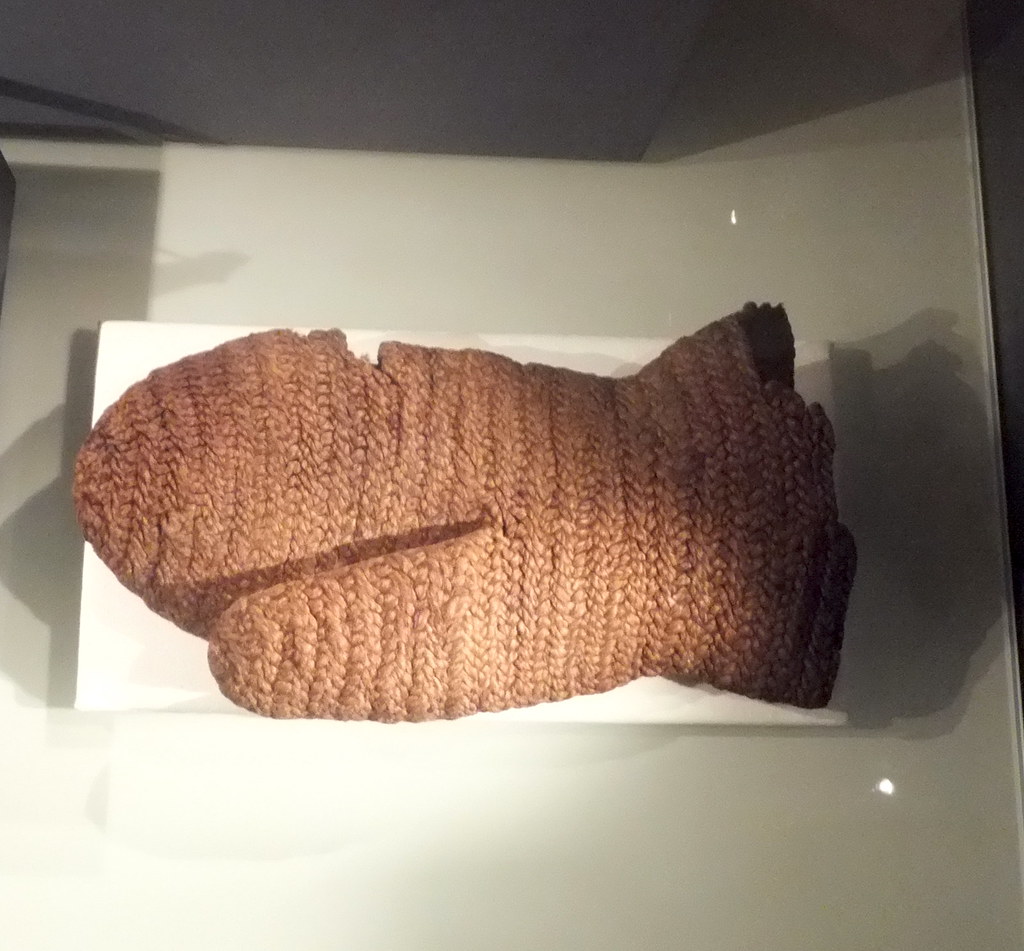Here in the flatlands of England, it's been hovering around 10-12 degrees (the low fifties Fahrenheit) for the past few weeks--just a little bit colder and I'll be wearing mittens every time I leave the house. This week I'm trying to finish a review of Ian Wood and Alexander O'Hara's translation of Jonas of Bobbio's Life of Columbanus. Columbanus was a cantankerous seventh century Irish saint who spent his life founding monasteries, standing up to royalty, and deploring the state of Christian observance in Gaul (where he moved permanently early in his career). In this post, I want to leave Jonas' colourful and opinionated account aside, and focus on a question of true interest: is this the first medieval Latin text to mention mittens?
Our evidence from Jonas is the following:
Another time when he (the blessed Columbanus) had come to eat at the aforesaid monastery of Luxeuil, he laid his gloves, which the Gauls call wantos, and which he was accustomed to wear when working, on a stone which was outside the door of the refectory. As soon as it became quiet, a raven, a thievish bird, flew up and snatched away one of the gloves in its beak. After the meal, the man of God went outside to get his gloves. When everyone was wondering among themselves who could have take [the glove], the holy man declared that no one would dare touch it without his permission except that bird which was sent out by Noah and did not return to the ark. And he added that the raven would not be able to feed its young if it did not quickly restore what had been rapaciously stolen. Then, while everyone was waiting, the raven flies into their midst bringing back what it had stolen in its wicked beak. And it does not attempt to fly away again, but humbly in the sight of all and forgetful of its wild nature awaits punishment. The holy man instead orders it to depart. [Wood and O'Hara, Life of Columbanus, pp 126-7]
 |
| The thief! "Raven" by Sergey Yeliseev is licensed under CC BY-NC-ND 2.0 |
As Wood and O'Hara note in the footnote, the term they translate as gloves is literally tegumenta manuum ('covering for the hands'); they say that the local word, wantos, 'becomes the modern French 'gants'' and that Jonas remarking on this different shows 'that he was writing from an Italian perspective' (p 126 n 186). Jonas was a monk from the northern Italian town of Susa, acquiring the sobriquet of Bobbio as that was the monastery where he entered religious life, and later in his career he spent some time working as a missionary on the northeastern borders of the Frankish kingdom--so from his perspective Frankish vocabulary was new and interesting, and worth defining for someone who might not know it.
What exactly is he describing here? What are wantos?
Firstly, despite my initial excitement about mittens (I had just started knitting a pair when this passage caught my eye), Jonas probably isn't describing knitted mittens. There are two reasons for this. Firstly, Jonas never describes the specifics of the hand coverings. Clearly, it was something durable: the chapter this miracle is included in contains two other miracles, all of them concerned in some way with outdoor work: one of which involves the miraculous healing of someone who accidentally cut off his finger with a very sharp sickle, the second a man who was healed after being struck in the forehead by a bit of debris while splitting wood; and then finally the miracle we're concerned with, where the type of work isn't specified, but the fact that Columbanus left his tegumenta manuum on a stone outside suggests muck of some kind was involved.
Secondly, if the mitten was made of yarn, it likely wasn't knitted. As far as can be seen from archaeological discoveries of Viking-era and early medieval textiles, the most popular technique for making fabric out of sticks and string was naalbinding (or nålebinding), which uses a thick needle with a large eye and short lengths of yarn to form a knit-like fabric through looped needle netting. Below is an example dating from sometime between the tenth and the twelfth century.
 |
| "Medieval mitten, National Museum of Iceland" by Lebatihem is licensed under CC BY-NC-ND 2. |
Jonas was writing in about 640--can we find a mitten closer to that date? The answer is yes--a woolen mitten dated from between 600 and 800 survives from Aalsum, in the Netherlands; and a mitten discovered at Dorestad, an important early medieval port near Utrecht, dating from between the seventh and the ninth centuries, was evidently deliberately felted to make it warmer and impermeable to wet and weather.
 | |
Mitten from Aalsum (Fries Museum, object nr. FM 33-374). Picture from the Twitter feed of the archaeologist Annemarieke Willemsen, who has written extensively about medieval gloves and hand-coverings. |
 |
Mitten found in Dorestad (National Museum of Antiquities Leiden, object nr. WD375.3.1) |
It's difficult to tell, but it looks almost like the Dorestad mitten has a top flap which might fold up over the fingers to allow the wearer greater dexterity. And there is a final consideration too: depending on the work Columbanus was doing, he might have found leather wantos rather than woolen ones a more comfortable and practical choice.
The waterlogged conditions at a sixth or seventh century Alamannic cemetary at Oberflacht, in southwestern Germany, preserved a wide array of wood, textiles, and leather--including, in the Grave 17, a set of leather gloves, described in William Wylie's translation of the 1847 German publication of the excavation,
No 17 contained a couch [wooden coffin]. In it were a singular pair of leather gloves, strongly laced on the back of the hand, and lined inside with a soft cloth, almost perished.
Wylie's article is accompanied by engravings but the gloves are sadly not among them. For a few pictures of what they might have looked like, Tomáš Vlasatý's 'Early Medieval Mittens' rounds up some interesting images (here)
When I went looking for other uses of the word wantos in the Monumenta Germaniae Historica (a freely available collection of editions of late antique and early medieval Latin texts), I discovered that what few mentions of wantos there are also appear to involve stories of them being stolen. The word appears in the Life of St. Philibert of Jumièges, Ch 12, which seems to be from mid-eighth century; and the Martyrology of Wolfhard of Herrieden, Book Three, Ch Four, which dates from c. 895. Both stories involve the miraculous prevention of the theft of gloves. A further reference also gives the sense that wantos were valuable: the Constitutio of Abbot Ansegisus of Fontanelle, (c. 823/833), lists a pound of gloves (ubantos) as one of the items the abbot gave to the monastery.
We began with the question of whether Columbanus' wantos are the first medieval Latin text to mention mittens. The answer to this question is both yes and no. As far as I can tell, this is the first medieval text to use the word wantos--it clearly wasn't a common word, and all other uses seem to be later than c. 640, when Jonas was writing. On the other hand, it's not entirely clear whether wantos is best translated as mitten (or glove), as none of the writers who use the word reveal whether the hand covering has separate fingers. Surviving examples of early medieval hand covering suggest that it didn't, making it likely that Columbanus' wantos was a mitten.
One thing is clear from the unexpected theft and return of Columbanus' mitten (or glove). Like handknitted mittens today, wantos were valued, and it was a miracle indeed to have a missing one restored.
Further Reading
Elizabeth Coatsworth and Gail Owen-Crocker, Clothing the Past: Surviving Garments from Early Medieval to Early Modern Europe (Leiden, 2018)
Ferdinand von Dürrich, and Wolfgang Menzel, Die Heidengräber am Lupfen (bei Oberflacht) (Stuttgart, 1847). Available from http://mdz-nbn-resolving.de/urn:nbn:de:bvb:12-bsb10003615-7.
'Gloves and Mittens from the Past', Medieval Histories (12 January 2016) Available from https://www.medieval.eu/gloves-and-mittens-from-the-past/ [accessed 18 October 2020]
Satu Novi, 'Viking and Medieval Nålebinding Mitten Replicas', Katajahovi (2017). Available from http://www.katajahovi.org/en/viking-and-medieval-nalebinding-mitten-replicas.html [accessed 18 October 2020]
Tomáš Vlasatý, 'Early Medieval Mittens', Projektu Forlǫg (19 January 2019) Available from https://sagy.vikingove.cz/early-medieval-mittens-and-gloves/ [accessed 18 October 2020]
Annemarieke Willemsen, 'The Geoff Egan Memorial Lecture 2013: Taking up the glove: finds, uses and meanings of gloves, mittens and gauntlets in western Europe, c. AD 1300–1700' Post-Medieval Archaeology 49:1 (2015), 1-36.
Ian Wood and Alexander O'Hara, Jonas of Bobbio: Life of Columbanus, Life of John of Reome, and Life of Vedast (Liverpool, 2017)
William Wylie, 'The Graves of the Alemanni at Oberflacht in Suabi' Archaeologia 36, (1855), pp. 129-168. (If you are interested in reading more about the Oberflacht gloves, I wasn't able to find a copy online, but Siegwalt Schiek's 1992 thesis Das Gräberfeld der Merowingerzeit bei Oberflacht looks like the best place to start).
For addutional roundups of archaeological discoveries, survivals, or depictions of medieval gloves and mittens, see the roundup at Medieval and Renaissance Material Culture (here); a shorter list can be found at The Viking Age Compendium by Gavin and Louise Archer (here)
And finally, because they're too amazing not to share, here is a pair of late medieval knitted gloves, made for a bishop in Spain.
So enjoyed reading this!
ReplyDeleteThank you, I'm glad to hear it! There are more mitten stories to come...
Delete